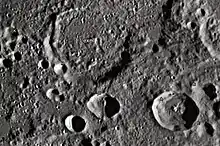 Lexell crater and its satellite craters taken from Earth in 2012 at the University of Hertfordshire's Bayfordbury Observatory with the telescopes Meade LX200 14" and Lumenera Skynyx 2-1 | |
| Coordinates | 35°48′S 4°12′W / 35.8°S 4.2°W |
|---|---|
| Diameter | 63 km |
| Depth | 2.2 km |
| Colongitude | 5° at sunrise |
| Eponym | Anders Johan Lexell |
Lexell is a lunar impact crater that lies across the southeastern rim of the huge walled plain Deslandres, in the southern part of the Moon. It was named after Swedish-Russian mathematician and astronomer Anders Johan Lexell.[1] To the northeast is the walled plain Walther, and to the south is Orontius, another walled plain.
This is a somewhat irregular formation with a wide break in the northern rim. The western rim forms a low, arcing wall, and is overlain to the southwest by Lexell H after passing the rim of Deslandres. The rim peaks along the southeast, then comes to an end at a rugged promontory-like ridge. The interior floor has been resurfaced by lava to the northwest and in sections of the remainder of the floor. There are some low rises and ghost-crater rims in the southeast half part of the interior floor.
Satellite craters
By convention these features are identified on lunar maps by placing the letter on the side of the crater midpoint that is closest to Lexell.
| Lexell | Latitude | Longitude | Diameter |
|---|---|---|---|
| A | 36.9° S | 1.4° W | 34 km |
| B | 37.3° S | 3.4° W | 23 km |
| D | 36.1° S | 0.7° W | 20 km |
| E | 37.2° S | 0.4° W | 16 km |
| F | 36.5° S | 5.4° W | 8 km |
| G | 37.2° S | 4.9° W | 10 km |
| H | 36.5° S | 4.9° W | 10 km |
| K | 35.9° S | 6.4° W | 10 km |
| L | 36.0° S | 6.0° W | 8 km |
References
- ↑ "Lexell (crater)". Gazetteer of Planetary Nomenclature. USGS Astrogeology Research Program.
- Andersson, L. E.; Whitaker, E. A. (1982). NASA Catalogue of Lunar Nomenclature. NASA RP-1097.
- Bussey, B.; Spudis, P. (2004). The Clementine Atlas of the Moon. New York: Cambridge University Press. ISBN 978-0-521-81528-4.
- Cocks, Elijah E.; Cocks, Josiah C. (1995). Who's Who on the Moon: A Biographical Dictionary of Lunar Nomenclature. Tudor Publishers. ISBN 978-0-936389-27-1.
- McDowell, Jonathan (July 15, 2007). "Lunar Nomenclature". Jonathan's Space Report. Retrieved 2007-10-24.
- Menzel, D. H.; Minnaert, M.; Levin, B.; Dollfus, A.; Bell, B. (1971). "Report on Lunar Nomenclature by the Working Group of Commission 17 of the IAU". Space Science Reviews. 12 (2): 136–186. Bibcode:1971SSRv...12..136M. doi:10.1007/BF00171763. S2CID 122125855.
- Moore, Patrick (2001). On the Moon. Sterling Publishing Co. ISBN 978-0-304-35469-6.
- Price, Fred W. (1988). The Moon Observer's Handbook. Cambridge University Press. ISBN 978-0-521-33500-3.
- Rükl, Antonín (1990). Atlas of the Moon. Kalmbach Books. ISBN 978-0-913135-17-4.
- Webb, Rev. T. W. (1962). Celestial Objects for Common Telescopes (6th revised ed.). Dover. ISBN 978-0-486-20917-3.
- Whitaker, Ewen A. (1999). Mapping and Naming the Moon. Cambridge University Press. ISBN 978-0-521-62248-6.
- Wlasuk, Peter T. (2000). Observing the Moon. Springer. ISBN 978-1-85233-193-1.
External links
- Wood, Chuck (October 5, 2007). "The Case of the Missing Rim". Lunar Photo of the Day. Archived from the original on October 27, 2007. Retrieved 2007-10-08.